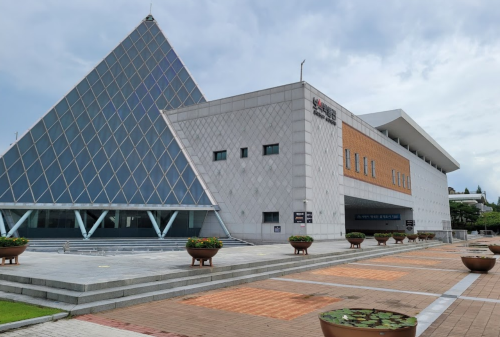App
Customer Support
NZD
Find Bookings
Popular Trip Moments
Gosrak Ewha Garden: Enjoying Organic Sauces and Nature | Gosrak Ewha Garden, a space where 5,000 jars come to life | Iksan Gosrak, where 5,000 jars breathe. | A Korean Restaurant with 5,000 Living Jars, Gosrak | 🏰 Time travel from Buyeo and Iksan, Baekje Historic Sites! ⏳✨ | Iksan Wonkwang University with cute Toka pottery💜 | Iksan Shinsang Bakery Cafe | Iksan Wonkwang University Museum with special exhibition✈️ | A large-scale Iksan Museum with three floors🙇♂️ | Train Station-Themed Unique Cafe 'Geumjong Bakery' | Spring trip to Wonkwang University to feel the university campus🥰 | ‘Glims Coffee Roasters’, a cafe remodeled from a mill | Medieval European atmosphere cafe ‘Cote d’Or’ | Places to visit for a 2-day, 1-night trip to Iksan | Recommended large cafes in Ungpo | A winter cafe trip to Iksan with a clean interior🥳 | Iksan emotional cafe with various desserts😍 | A trendy bakery that recently opened in Iksan😍 | A trip to Iksan that feels like a time machine trip 🤩 | Winter bakery trip to Iksan🥰 | A great cafe trip to Iksan with your girlfriend in spring 🤩 | A trip to a large cafe in Iksan that is great for winter🤩 | Iksan Shelter where you can meet and read various books🥰 | Iksan outdoor date spot to enjoy in a happy space🥳 | This is a unique cafe in Iksan with an attractive wooden interior😍 | Iksan Cafe, a coffee bean specialty restaurant with a unique interior design🤍 | A unique cafe remodeled from a rice mill, Glims Coffee Roasters☕️ | Iksan|A Hidden Gem in Korea | This Yiksan Hotel Offers a Unique Accommodation Experience
| Recommended must-visit course in Iksan: Iksan Modern History Museum
Recommended Attractions at Popular Destinations
Bangkok attraction near me | Manila attraction near me | Tokyo attraction near me | Taipei attraction near me | Hong Kong attraction near me | Seoul attraction near me | Kuala Lumpur attraction near me | Los Angeles attraction near me | Shanghai attraction near me | New York attraction near me | Shenzhen attraction near me | Osaka attraction near me | Singapore attraction near me | London attraction near me | Guangzhou attraction near me | San Francisco attraction near me | Beijing attraction near me | Macau attraction near me | Bali attraction near me | Jakarta attraction near me | Paris attraction near me | Ho Chi Minh City attraction near me | Istanbul attraction near me | Phuket attraction near me | Chicago attraction near me | Seattle attraction near me | Toronto attraction near me | Orlando attraction near me | Cebu attraction near me | Chiang Mai attraction near me
Popular Attractions
Hanamikoji Street | Kaili Miao-Dong Customs Park | Hong Kong Disneyland | Tianmen Mountain National Forest Park | Shiqian Ancient Hot Springs | Kiwi Park Queenstown | Xijiang Qianhu Miao Village | Century Park | Sydney Tower Eye | Wellington Cable Car | Christchurch Botanic Gardens | Pingyao Ancient City | Shanghai Science and Technology Museum | St Henry's Garden salaama rd | El Viejo Ilalo | Residence of Bruce Lee | 168 Stairs | Terminal Bersepadu Selatan | Ecuries du château de Chaumont-Laguiche | Main Gate of Roshanara Park | Krestyansky Dom PLC Exhibition Center | Castillo de Narboneta | Meldi Maa Mandir, Dudheshwar | Kirche Am Kalvarienberg | Clyde Grand Reserve | Scottsville Free Library | Masjid Nurul Iman | Kids Fun - Arung Jeram | Lake Ashi | Shiping Mountain Scenic Area
Popular Restaurants in Iksan-Si
Ground | Cafe Di and Di | JukStory Iksan Eoyang Store | Coffee Myeongga | Gongcha | Mano430 | 7 Street Raw Meat | Mcdonalds | Chamhan-U | Starbucks IkSan Yeongdeung | Syaron Restaurant | Coffee Ni | Pancake Ju Nammun Native Sundae Soup | Maenhatan | Npub 앤펍 | Minsogchon | 올댓뮤직 파머스브루어리 sports pub & live music | 오가네장뇌삼한방백숙 | Kino | Revival | Hana Yori Dango (Japanese) | Mar Rueda | Malg eum | Chahyang-Gi | nun-kkoch-tteul | Coffee Belt | CONCEPT1 | Gui쟁이 원광대점 | Dutumdutum | Elbegang
Popular Ranked Lists
Popular Best Things to Do in Qianwei County | Popular Luxury Hotels Near Fell Lapland | Top 8 Best Things to Do in Dandong | Popular Local Restaurants in Quanzhou | Popular Best Things to Do in Tongdao | Popular Luxury Hotels Near Odiaxere | Top 5 Best Things to Do in Jingxi | Popular Luxury Hotels Near Bridgewater | Top 19 Local Restaurants in Dali | Top 3 Best Things to Do in Fuzhou | Top 14 Local Restaurants in Doha | Popular Best Things to Do in Longchang | Top 19 Local Restaurants in Nara | Popular Local Restaurants in Shenzhen | Popular Luxury Hotels Near Kittila | Popular Luxury Hotels Near Takeo | Popular Luxury Hotels Near Maggona | Popular Luxury Hotels in Puntarenas | Top 20 Local Restaurants in Zhengzhou | Top 4 Best Things to Do in Changzhi | Top 10 Local Restaurants in Zhanjiang | Popular Premium Hotels in Kutaisi | Popular Premium Hotels in Torquay | Top 4 Best Things to Do in Daxin | Top 18 Local Restaurants in Los Angeles | Popular Best Things to Do in Nan'ao | Popular Premium Hotels in En Gev | Top 20 Local Restaurants in Zurich | Top 4 Best Things to Do in Changji Prefecture | Popular Local Restaurants in Changsha
Payment Methods
Our Partners
Copyright © 2025 Trip.com Travel Singapore Pte. Ltd. All rights reserved
Site Operator: Trip.com Travel Singapore Pte. Ltd.
Site Operator: Trip.com Travel Singapore Pte. Ltd.






















